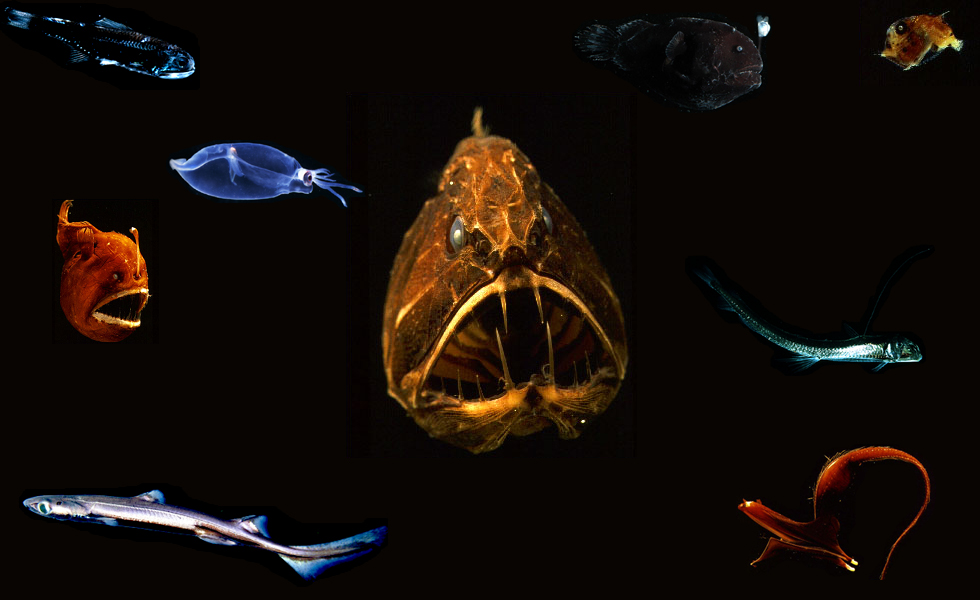Saturday, March 04, 2006
The World's Smallest Fish
I shall begin this series with a post on some news that many of us might have read or heard about in the news in January.
Paedocypris progenetica, the world's smallest vertebrate
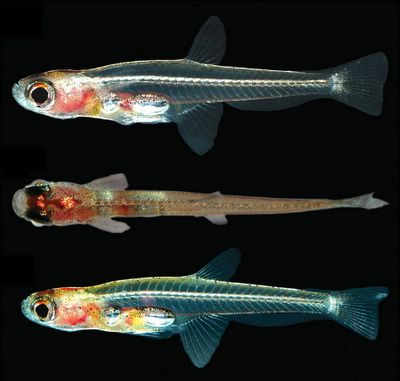
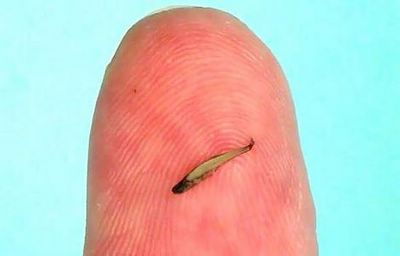
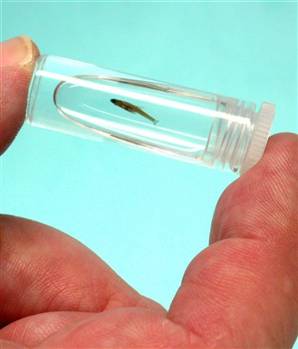
This is truly a fish that makes ikan bilis look huge in comparison; a mature female was measured at just 7.9 millimetres in length.
Paedocypris belongs to the Cyprinidae, a large family of fishes that are familiar to most of us; the Cyprinidae includes such diverse species like carp, goldfish, the various species of barbs, rasboras and danios familiar in home aquaria, plus a great deal of other species.
The genus was described in the Proceedings of the Royal Society of London B, by Maurice Kottelat and Tan Heok Hui, who are researchers at the Raffles Museum of Biodiversity Research at the National University of Singapore. They were assisted by Ralf Britz of Britain's National Museum of Natural History and Kai-Erik Witte at the Max Planck Institute for Developmental Biology in Tuebingen, Germany.
This new genus is currently comprised of 2 species, Paedocypris progenetica of Sumatra, and the slightly larger Paedocypris micromegethes from Sarawak, which reaches 8.8 millimetres in length.

Paedocypris micromegethes
The generic name refers to the fishes' retention of larval characteristics during adulthood (Paideois is Greek for child) and their systematic affinity (cyprinus is Latin for carp). As for the species epithets, progenetica refers to the truncated development of the adult fish, while micromegethes means small in size in Greek.


Both these species inhabit the highly acidic peat swamps. Presumably, further exploration might reveal other species of this new and enigmatic genus in other peat swamp forests elsewhere in Southeast Asia. These so-called "blackwater" swamps are a unique landscape of flooded trees growing in water-logged, soft peaty soil that is often several meters (10 feet) thick.
The bloated fish were actually carrying eggs - a sign of a mature female.
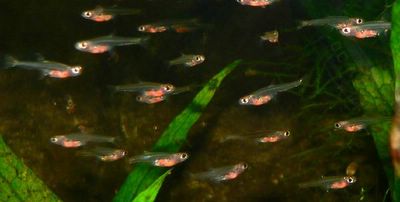
Another interesting feature of Paedocypris is that it demonstrates paedomorphosis, or the retention of juvenile traits into adulthood. Adults are transparent and lack scales, possess a conspicuous skin fold along the lower edge of the caudal peduncle (a larval trait), lack certain bones, and even more interestingly, the frontals are narrow, leaving the brain unprotected dorsally.
Other interesting adaptations include a feature unique among fishes – a complex pelvic girdle, in which the first pelvic-fin ray and its abductor muscles are hypertrophied and highly modified. The authors suggest that this is an adaptation for reproductive advantage. The pelvic fin could form a clasping device in conjunction with the prepelvic keratinised pad.
Such a hypothesis may be tested with observation of behaviour and reproduction. Despite the fish's delicate nature, it is possible that in future, dedicated aquarists with an eye for the odd (and with a good magnifying glass or microscope) may be able to contribute data.
Only in recent years have the secrets of the peat swamps been gradually revealed as researchers venture into the acidic, tannin-stained waters.
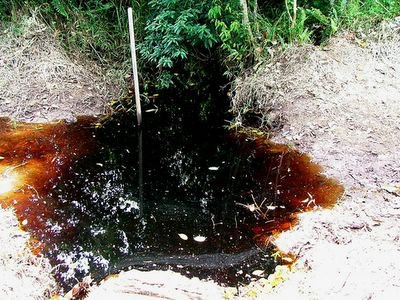
Contrary to popular thought, these swamps do not harbour mosquitoes, due to the high acidity of the water.
Vanishing Habitats

Peat swamp in Jambi, Sumatra, habitat of Paedocypris progenetica.
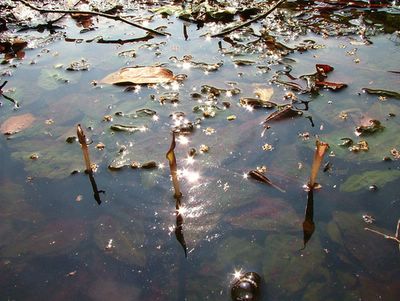
Peat swamp in Sarawak, Borneo, habitat of Paedocypris micromegethes.
However, there is a bleak side to this story. The peat swamp forests of Southeast Asia are severely threatened with destruction from logging and agriculture. And with the loss of these forests, an entire ecosystem is lost forever.
Much attention has been paid to the burning of rainforests in Malaysia and Indonesia. Peat swamp forest is especially susceptible to fire, due to the accumulation of peat, resulting in a great amount of carbon being stored away. However, peat swamp fires appear intimately connected to drainage, logging and adjacent land development — activities which influence the water tables in the peat swamps.
"Lowering water tables and opening up the forest canopy promotes the risk of fire in peat soils," according to Faizal Parish, executive director of conservation group Wetlands International Asia Pacific.
Peat swamp infernos have become more common in this region in recent years. "This was not the case up until 10 years ago," he says. The advent of peat swamp fires, he adds, parallels logging and draining of water from peat swamps.
Draining the peat swamp leads to trouble. Canals dug into the peat, in effect, bleeds the swamp of the very medium that is its basis of existence. When the water level recedes, the upper layer of plant material dries up, thus becoming combustible fuel.
Once a fire breaks out in peat swamps, it is an arduous task controlling it — flames often continue to smoulder underground, fed by the dried peat. In recent Sumatran fires, Malaysian fire-fighters resorted to digging out the smouldering coal.
And even if the fires are put out, the succession of grassland vegetation on the land increases the risk of fire occurring once again.

Peat swamp decimated by fire.
In fact, that may be the fate which has befallen another population of Paedocypris. Apparently, Paedocypris is also known from peninsular Malaysia. However, it is currently known from only one locale in Selangor. Yet, as a student who worked with Tan Heok Hui's team reveals, it might have been too late already:
We can only keep our fingers crossed.
But the apparently extensive range of this genus raises an interesting question. Did small schools of Paedocypris once swim in the waters of Singapore's peat swamp forests, only to vanish under the encroachment of agriculture and urbanisation? Or might there be a day when some intrepid naturalist takes a closer look at a school of tiny fish swimming in the heart of the Nee Soon swamp forest, and demonstrate once again that where it comes to Singapore's biodiversity, a surprise is always waiting around the corner?
My fish is smaller than your fish
The discovery of Paedocypris broke another record, that of the world's smallest freshwater fish. Since 1986, the title had been held by Danionella translucida another dimunitive cyprinid from Myanmar that measures a mere 12 millimetres in length.

Danionella translucida
And so, at present, the 3 smallest freshwater fish are Paedocypris progenetica (7.9 mm), Paedocypris micromegethes (8.8 mm), and Danionella translucida (12 mm).
Where it comes to world records in the fish world, the title of smallest fish has been hotly contested for years. While the positions of the whale shark (Rhincodon typus) and basking shark (Cetorhinus maximus) as the world's largest fish have gone unchallenged for decades (14 metres and 12 metres in length, respectively), every other year it seems a new record is broken where it comes to selecting the smallest species.
Older books will claim that the holder of the world's smallest fish would be the Dwarf Pygmy Goby, Pandaka pygmaea, discovered in 1927. A tiny goby measuring 11 millimetres in length, this fish inhabits brackish waters and estuaries from peninsular Malaysia east to the Philippines.
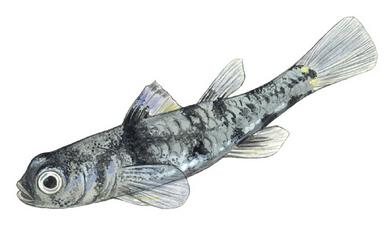
Pandaka pygmaea
Then in 1981, came the Dwarf Goby Trimmatom nanus, another tiny goby from the coral reefs of the Chagos Archipelago and Maldives in the Indian Ocean, as well as the western Pacific. With females maturing at 8 millimetres in length and possessing an average length of 8.9 millimetres, and males possessing an average length of 8.6 millimetres, it held the title of world's smallest fish until 2004, when its position was usurped.
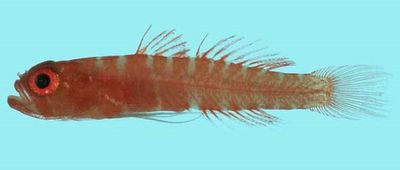
Trimmatom nanus
The new title holder that replaced the Dwarf Goby in 2004 was the Stout Infantfish Schindleria brevipinguis, a relative of the gobies that so far has been discovered only in the seas around the Great Barrier Reef in Australia. Like so many other tiny species, the infantfish possess paedomorphic features; it is easy to mistake them for the fry and larvae of larger species. Adults are transparent, and grow to a maximum total length of 8.4 millimetres, with males being mature at a length of 7 millimetres. In life, the fish is completely transparent; the fish shown below is a preserved specimen.

Schindleria brevipinguis


Yes, that tiny little sliver is an Infantfish.
The Stout infantfish held the record until January 2006, when Paedocypris progenetica arrived on the scene.
And in a bizarre twist, barely a week after newspapers the world over trumpeted the new record-holder for the world's smallest fish, there arrived a new challenger - Photocorynus spiniceps, a species of deep-sea anglerfish.

Photocorynus spiniceps
Anglerfish are an ugly lot. While there are many species that inhabit the shallows, they are most famous for the many species that inhabit the deepest, darkest depths of the ocean, beyond the reach of sunlight. In many species, a modified dorsal fin acts as a bioluminescent lure, emitting a faint glow that attracts smaller fish and crustaceans which are then captured with needle-sharp fangs.
In total darkness, and in such a bleak landscape, food is scarce, and mates are scarcer still. Finding a mate might be next to impossible, so many deep-sea anglerfish have evolved a bizarre reproductive behaviour known as sexual parasitism.
Female anglerfish are ugly creatures, with gaping mouths filled with needle-sharp teeth, and bloated bodies. But the males are even stranger still; a mere fraction of the female's size, they roam the ocean depths, seeking out a potential mate with their enlarged eyes and nostrils. When he comes upon a female of the right species, he bites her and holds on. As time passes, something very strange happens indeed - The male practically fuses with the female. He degenerates, in all respects becoming nothing more than an attached set of testes. The female will share her circulatory system with the male; he has turned into a parasite, and she will sustain them both. The two have truly become one. Eventually, the only sign of the male's existence would be a small protruberance on the female; you could never have guessed that the two were of the same species.
Which brings us to our newest challenger.
Ted Pietsch of the University of Washington found a museum specimen of Photocorynus spiniceps that had been collected in the Philippines. At first it hardly appears to be a serious competitor for the title of world's smallest fish; after all, it is a female 46 millimetres long.
However, a closer look reveals the presence of a tiny male, attached to her back; he is a mere 6.2 millimetres long - a full 1.7 millimetres shorter than the shortest mature specimen of Paedocypris progenetica.

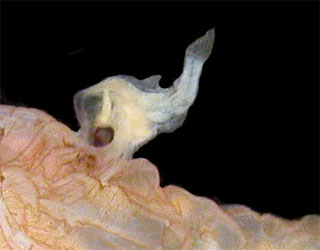
So this is the smallest fish in the world.
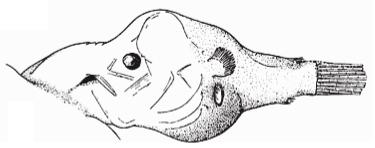
Illustration of male attached to female.
Hence, although the title of world's smallest fish now belongs to Photocorynus spiniceps, Paedocypris progenetica remains the world's smallest freshwater fish.
However, one has to note that where Photocorynus spiniceps is concerned, only a certain percentage of the population gets to be this small. Below is a photo showing both male and female individuals of the world's smallest marine fish and the world's smallest freshwater fish, to scale.
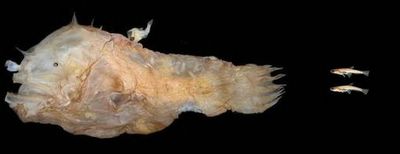
L: Male and female Photocorynus spiniceps
R: Male and female Paedocypris progeneticas
And the original discoverers of Paedocypris are not amused.
Even the discoverers of the Stout infantfish have joined in the fray. H.J. Walker and William Watson note that when the International Game Fish Association gives out its coveted world records, they are not for length, but for weight or mass. Watson and Walker base their claim on the fact that the Stout Infantfish is far more slender, and thus lighter than either of the other species.
So, it all boils down to what fits your own criteria. Does weight count, or is it solely based on length? Does it count when only one sex of the species gets to such a dimunitive size? The differences in size are best demonstrated with the following graphic:

Anglers and sports fishermen may compete to hook the largest fish, but on the other end of the spectrum, the fight for the world's smallest fish is just as fierce.
Kottelat, M., R. Britz, Tan. H. H. & K-E. Witte, 2006. Paedocypris, a new genus of Southeast Asian cyprinid fish with a remarkable sexual dimorphism, comprises the world's smallest vertebrate. Proceedings of the Royal Society of London B: Biological Sciences doi:10.1098/rspb.2005.3419. (Describes Paedocypris progenetica and P. micromegethes)
Pietsch, T.W., 2005. Dimorphism, parastitism, and sex revisited: Modes of reproduction among deep-sea ceratioid anglerfishes (Teleostei: Lophiiformes). Ichthyological Research, 52(33): 207-236. (Documents the 6.2 millimetre-long male Photocorynus spiniceps)
Watson, W. & H.J. Walker Jr., 2004. The world's smallest vertebrate, Schindleria brevipinguis, a new paedomorphic species in the family Schindleriidae (Perciformes: Gobioidei). Records of the Australian Museum. 56(2): 139-142. (Described Schindleria brevipinguis)
Paedocypris progenetica, the world's smallest vertebrate



This is truly a fish that makes ikan bilis look huge in comparison; a mature female was measured at just 7.9 millimetres in length.
Paedocypris belongs to the Cyprinidae, a large family of fishes that are familiar to most of us; the Cyprinidae includes such diverse species like carp, goldfish, the various species of barbs, rasboras and danios familiar in home aquaria, plus a great deal of other species.
The genus was described in the Proceedings of the Royal Society of London B, by Maurice Kottelat and Tan Heok Hui, who are researchers at the Raffles Museum of Biodiversity Research at the National University of Singapore. They were assisted by Ralf Britz of Britain's National Museum of Natural History and Kai-Erik Witte at the Max Planck Institute for Developmental Biology in Tuebingen, Germany.
This new genus is currently comprised of 2 species, Paedocypris progenetica of Sumatra, and the slightly larger Paedocypris micromegethes from Sarawak, which reaches 8.8 millimetres in length.

Paedocypris micromegethes
The generic name refers to the fishes' retention of larval characteristics during adulthood (Paideois is Greek for child) and their systematic affinity (cyprinus is Latin for carp). As for the species epithets, progenetica refers to the truncated development of the adult fish, while micromegethes means small in size in Greek.


Both these species inhabit the highly acidic peat swamps. Presumably, further exploration might reveal other species of this new and enigmatic genus in other peat swamp forests elsewhere in Southeast Asia. These so-called "blackwater" swamps are a unique landscape of flooded trees growing in water-logged, soft peaty soil that is often several meters (10 feet) thick.
"It is something totally unexpected. In fact when we first got the fish, our reaction was "it's all juveniles, why are there so many of it?" And on closer inspection under the microscope we saw some of them are so bloated."
- Dr Tan Heok Hui
The bloated fish were actually carrying eggs - a sign of a mature female.

Another interesting feature of Paedocypris is that it demonstrates paedomorphosis, or the retention of juvenile traits into adulthood. Adults are transparent and lack scales, possess a conspicuous skin fold along the lower edge of the caudal peduncle (a larval trait), lack certain bones, and even more interestingly, the frontals are narrow, leaving the brain unprotected dorsally.
Other interesting adaptations include a feature unique among fishes – a complex pelvic girdle, in which the first pelvic-fin ray and its abductor muscles are hypertrophied and highly modified. The authors suggest that this is an adaptation for reproductive advantage. The pelvic fin could form a clasping device in conjunction with the prepelvic keratinised pad.
Such a hypothesis may be tested with observation of behaviour and reproduction. Despite the fish's delicate nature, it is possible that in future, dedicated aquarists with an eye for the odd (and with a good magnifying glass or microscope) may be able to contribute data.
Only in recent years have the secrets of the peat swamps been gradually revealed as researchers venture into the acidic, tannin-stained waters.

Contrary to popular thought, these swamps do not harbour mosquitoes, due to the high acidity of the water.
The pH of such swamp waters can be as low as 3 — about the same as vinegar. "Until recently, peat swamps were assumed to be hostile, acidic places where the biodiversity was low," says Ng. "But that's because no one had actually jumped in." After taking the plunge into numerous swamps on the Malay Peninsula and the islands of Borneo and Sumatra, Ng's team has found some 80 fish new to science, bringing the estimate of the total number of species in the swamps to 200–300. "My students say they have too much to study," he says. A high proportion of the species are exclusive to the peat-swamp environment.
Vanishing Habitats

Peat swamp in Jambi, Sumatra, habitat of Paedocypris progenetica.

Peat swamp in Sarawak, Borneo, habitat of Paedocypris micromegethes.
However, there is a bleak side to this story. The peat swamp forests of Southeast Asia are severely threatened with destruction from logging and agriculture. And with the loss of these forests, an entire ecosystem is lost forever.
Much attention has been paid to the burning of rainforests in Malaysia and Indonesia. Peat swamp forest is especially susceptible to fire, due to the accumulation of peat, resulting in a great amount of carbon being stored away. However, peat swamp fires appear intimately connected to drainage, logging and adjacent land development — activities which influence the water tables in the peat swamps.
"Lowering water tables and opening up the forest canopy promotes the risk of fire in peat soils," according to Faizal Parish, executive director of conservation group Wetlands International Asia Pacific.
Peat swamp infernos have become more common in this region in recent years. "This was not the case up until 10 years ago," he says. The advent of peat swamp fires, he adds, parallels logging and draining of water from peat swamps.
Draining the peat swamp leads to trouble. Canals dug into the peat, in effect, bleeds the swamp of the very medium that is its basis of existence. When the water level recedes, the upper layer of plant material dries up, thus becoming combustible fuel.
Once a fire breaks out in peat swamps, it is an arduous task controlling it — flames often continue to smoulder underground, fed by the dried peat. In recent Sumatran fires, Malaysian fire-fighters resorted to digging out the smouldering coal.
And even if the fires are put out, the succession of grassland vegetation on the land increases the risk of fire occurring once again.

Peat swamp decimated by fire.
In fact, that may be the fate which has befallen another population of Paedocypris. Apparently, Paedocypris is also known from peninsular Malaysia. However, it is currently known from only one locale in Selangor. Yet, as a student who worked with Tan Heok Hui's team reveals, it might have been too late already:
I was supposed to study the behaviour of Paedocypris for my Research project in NUS.
JANUARY 2005
I visited North Selangor Peat Swamp (NSPSF) with Dr Tan in January 2005 to collect this fish. We visited all the sites that the fish had been previously collected. We could not catch a single fish. On top of that, of other peat swamp species, we caught fewer fish species than previous collections in NSPSF.
This may have been because of two reason, 1) The fish is seasonal, 2) North Selangor was in the process of being drained for agriculture, the disturbance may have caused the species to go extinct.
JULY 2005
I visited these same sites in July 2005. By this time the swamp was in worse condition. The streams were all nearly dry and overgrown with vegetation, we sampled here and again found no Paedocypris, and found even fewer fish species than we had in January.
OVERVIEW
50 species of fish have been collected from North Selangor Peat swamp forest (NSPSF), 20 of which can only survive in the acid water conditions of peat swamp forests, and a further 5 species restricted to NSPSF.
Paedocypris sp.
Betta livida
Betta hipposideros
Parosphromenus harveyi
Encheloclarias curtisoma
North Selangor is nearly completely dry, in the process of being logged and converted to agriculture. If not alreay extinct, Paedocypris and the other 4 species listed above are safely on the way to extinction....
We can only keep our fingers crossed.
But the apparently extensive range of this genus raises an interesting question. Did small schools of Paedocypris once swim in the waters of Singapore's peat swamp forests, only to vanish under the encroachment of agriculture and urbanisation? Or might there be a day when some intrepid naturalist takes a closer look at a school of tiny fish swimming in the heart of the Nee Soon swamp forest, and demonstrate once again that where it comes to Singapore's biodiversity, a surprise is always waiting around the corner?
My fish is smaller than your fish
The discovery of Paedocypris broke another record, that of the world's smallest freshwater fish. Since 1986, the title had been held by Danionella translucida another dimunitive cyprinid from Myanmar that measures a mere 12 millimetres in length.

Danionella translucida
And so, at present, the 3 smallest freshwater fish are Paedocypris progenetica (7.9 mm), Paedocypris micromegethes (8.8 mm), and Danionella translucida (12 mm).
Where it comes to world records in the fish world, the title of smallest fish has been hotly contested for years. While the positions of the whale shark (Rhincodon typus) and basking shark (Cetorhinus maximus) as the world's largest fish have gone unchallenged for decades (14 metres and 12 metres in length, respectively), every other year it seems a new record is broken where it comes to selecting the smallest species.
Older books will claim that the holder of the world's smallest fish would be the Dwarf Pygmy Goby, Pandaka pygmaea, discovered in 1927. A tiny goby measuring 11 millimetres in length, this fish inhabits brackish waters and estuaries from peninsular Malaysia east to the Philippines.

Pandaka pygmaea
Then in 1981, came the Dwarf Goby Trimmatom nanus, another tiny goby from the coral reefs of the Chagos Archipelago and Maldives in the Indian Ocean, as well as the western Pacific. With females maturing at 8 millimetres in length and possessing an average length of 8.9 millimetres, and males possessing an average length of 8.6 millimetres, it held the title of world's smallest fish until 2004, when its position was usurped.

Trimmatom nanus
The new title holder that replaced the Dwarf Goby in 2004 was the Stout Infantfish Schindleria brevipinguis, a relative of the gobies that so far has been discovered only in the seas around the Great Barrier Reef in Australia. Like so many other tiny species, the infantfish possess paedomorphic features; it is easy to mistake them for the fry and larvae of larger species. Adults are transparent, and grow to a maximum total length of 8.4 millimetres, with males being mature at a length of 7 millimetres. In life, the fish is completely transparent; the fish shown below is a preserved specimen.

Schindleria brevipinguis


Yes, that tiny little sliver is an Infantfish.
The Stout infantfish held the record until January 2006, when Paedocypris progenetica arrived on the scene.
And in a bizarre twist, barely a week after newspapers the world over trumpeted the new record-holder for the world's smallest fish, there arrived a new challenger - Photocorynus spiniceps, a species of deep-sea anglerfish.

Photocorynus spiniceps
Anglerfish are an ugly lot. While there are many species that inhabit the shallows, they are most famous for the many species that inhabit the deepest, darkest depths of the ocean, beyond the reach of sunlight. In many species, a modified dorsal fin acts as a bioluminescent lure, emitting a faint glow that attracts smaller fish and crustaceans which are then captured with needle-sharp fangs.
In total darkness, and in such a bleak landscape, food is scarce, and mates are scarcer still. Finding a mate might be next to impossible, so many deep-sea anglerfish have evolved a bizarre reproductive behaviour known as sexual parasitism.
Female anglerfish are ugly creatures, with gaping mouths filled with needle-sharp teeth, and bloated bodies. But the males are even stranger still; a mere fraction of the female's size, they roam the ocean depths, seeking out a potential mate with their enlarged eyes and nostrils. When he comes upon a female of the right species, he bites her and holds on. As time passes, something very strange happens indeed - The male practically fuses with the female. He degenerates, in all respects becoming nothing more than an attached set of testes. The female will share her circulatory system with the male; he has turned into a parasite, and she will sustain them both. The two have truly become one. Eventually, the only sign of the male's existence would be a small protruberance on the female; you could never have guessed that the two were of the same species.
Which brings us to our newest challenger.
Ted Pietsch of the University of Washington found a museum specimen of Photocorynus spiniceps that had been collected in the Philippines. At first it hardly appears to be a serious competitor for the title of world's smallest fish; after all, it is a female 46 millimetres long.
However, a closer look reveals the presence of a tiny male, attached to her back; he is a mere 6.2 millimetres long - a full 1.7 millimetres shorter than the shortest mature specimen of Paedocypris progenetica.


So this is the smallest fish in the world.

Illustration of male attached to female.
Hence, although the title of world's smallest fish now belongs to Photocorynus spiniceps, Paedocypris progenetica remains the world's smallest freshwater fish.
However, one has to note that where Photocorynus spiniceps is concerned, only a certain percentage of the population gets to be this small. Below is a photo showing both male and female individuals of the world's smallest marine fish and the world's smallest freshwater fish, to scale.

L: Male and female Photocorynus spiniceps
R: Male and female Paedocypris progeneticas
And the original discoverers of Paedocypris are not amused.
"We are talking about the smallest fish species... If the female was also small then you could discuss this. But you cannot go by the mature size of just one sex."
- Maurice Kottelat
Even the discoverers of the Stout infantfish have joined in the fray. H.J. Walker and William Watson note that when the International Game Fish Association gives out its coveted world records, they are not for length, but for weight or mass. Watson and Walker base their claim on the fact that the Stout Infantfish is far more slender, and thus lighter than either of the other species.
"Mass really ought to come into it, rather than just plain length,"
- Watson
So, it all boils down to what fits your own criteria. Does weight count, or is it solely based on length? Does it count when only one sex of the species gets to such a dimunitive size? The differences in size are best demonstrated with the following graphic:

Anglers and sports fishermen may compete to hook the largest fish, but on the other end of the spectrum, the fight for the world's smallest fish is just as fierce.
Kottelat, M., R. Britz, Tan. H. H. & K-E. Witte, 2006. Paedocypris, a new genus of Southeast Asian cyprinid fish with a remarkable sexual dimorphism, comprises the world's smallest vertebrate. Proceedings of the Royal Society of London B: Biological Sciences doi:10.1098/rspb.2005.3419. (Describes Paedocypris progenetica and P. micromegethes)
Pietsch, T.W., 2005. Dimorphism, parastitism, and sex revisited: Modes of reproduction among deep-sea ceratioid anglerfishes (Teleostei: Lophiiformes). Ichthyological Research, 52(33): 207-236. (Documents the 6.2 millimetre-long male Photocorynus spiniceps)
Watson, W. & H.J. Walker Jr., 2004. The world's smallest vertebrate, Schindleria brevipinguis, a new paedomorphic species in the family Schindleriidae (Perciformes: Gobioidei). Records of the Australian Museum. 56(2): 139-142. (Described Schindleria brevipinguis)

